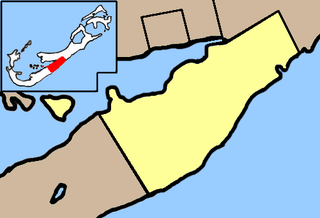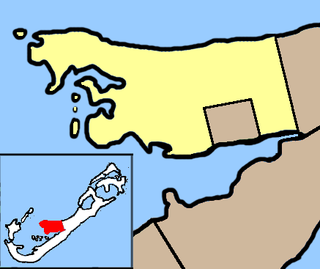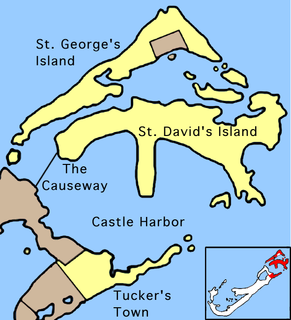

Smith's Parish is one of the nine parishes of Bermuda. It is named for English aristocrat Sir Thomas Smith/Smythe (1558-1625).


Smith's Parish is one of the nine parishes of Bermuda. It is named for English aristocrat Sir Thomas Smith/Smythe (1558-1625).
It is located in the northeast of the main island, at the southern end of Harrington Sound, the large lagoon close to the main island's northeastern tip. It is joined to Devonshire Parish in the southwest and Hamilton Parish in the northeast. As with most of Bermuda's parishes, it covers just over 2.3 square miles (about 6.0 km² or 1500 acres). It had a population of 5,984 in 2016. [1]
Natural features in Smith's include Spittal Pond, John Smith's Beach, Devil's Hole, Gibbet Island, and Portuagese Rock.
Like all of parishes of Bermuda, Smith's was named after one of the nine chief investors of the Somers Isles (Bermuda) Company. In this case, it was named for the Company's first governor, Sir Thomas Smith, who also acted as a governor for the East India Company and treasurer of the Virginia Company. Smith would go on to invest some £60,000 into Bermuda (only £20,000 less than what he invested in the much larger Virginia). Despite this, his contribution to his stake in the colony was minimal, and the area was briefly known as "Harris' Bay".
For purposes of national representation, Smith's has been divided into three constituencies (Smith's South, Smith's West and Smith's North), and so has 3 representatives in Parliament. As of 2003, two of these are members of the UBP party, and one is a member of the PLP party.
Schools in the Parish:

Bermuda is a British Overseas Territory in the North Atlantic Ocean. It is approximately 1,035 km (643 mi) east-southeast of Cape Hatteras, North Carolina ; 1,236 km (768 mi) south of Cape Sable Island, Nova Scotia; 1,759 km (1,093 mi) northeast of Cuba, and 1,538 km (956 mi) due north of the British Virgin Islands. Though it is typically referred to in the singular, Bermuda consists of 181 islands; the largest of these islands is known as Main Island. The capital city of Bermuda is Hamilton. Bermuda is internally self-governing, with its own constitution and cabinet of ministers selected from the elected Members of the lower house of a Parliament that enacts local laws. As the national government, the Government of the United Kingdom is ultimately responsible for ensuring good governance within British Overseas Territories, and retains responsibility for defence and foreign relations. As of July 2018, it has a population of 71,176, making it the most populous of the British overseas territories. Bermuda's largest economic sectors are offshore insurance, reinsurance, and tourism. Bermuda had one of the world's highest GDP per capita for most of the 20th century.

The Colony of Virginia, chartered in 1606 and settled in 1607, was the first enduring English colony in North America, following failed proprietary attempts at settlement on Newfoundland by Sir Humphrey Gilbert in 1583, and the subsequent farther south Roanoke Island by Sir Walter Raleigh in the late 1580s.

The London Company was an English joint-stock company established in 1606 by royal charter by King James I with the purpose of establishing colonial settlements in North America.

St. George's, located on the island and within the parish of the same names, settled in 1612, is the first permanent English settlement on the islands of Bermuda. It is often described as the third successful British settlement in the Americas, after St. John's, Newfoundland, and Jamestown, Virginia and the oldest continuously-inhabited British town in the New World, since the other two settlements were seasonal for a number of years.

Sir Thomas Dale was an English naval commander and deputy-governor of the Virginia Colony in 1611 and from 1614 to 1616. Governor Dale is best remembered for the energy and the extreme rigour of his administration in Virginia, which established order and in various ways seems to have benefited the colony, although he was criticised for high-handedness. He is also credited with the establishment of Bermuda Hundred, Bermuda Cittie, and the Cittie of Henricus.

Sandys Parish ( "sands") is one of the nine parishes of Bermuda. It is named for English aristocrat Sir Edwin Sandys (1561–1629), and hence there is no apostrophe in the name.

Southampton Parish is one of the nine parishes of Bermuda. It is named for Henry Wriothesley, 3rd Earl of Southampton (1573-1624).

Warwick Parish is one of the nine parishes of Bermuda. It is named after Robert Rich, 2nd Earl of Warwick (1587-1658).

Paget Parish is one of the nine parishes of Bermuda. It is named for William Paget, 4th Baron Paget de Beaudesert (1572–1629).

Pembroke Parish is one of the nine parishes of Bermuda. It is named after English aristocrat William Herbert, 3rd Earl of Pembroke (1580–1630).

Devonshire Parish is one of the nine parishes of Bermuda. Originally named Cavendish Tribe and later Devonshire Tribe, for William Cavendish, 1st Earl of Devonshire (1552–1626), who never visited Bermuda, despite a parish being named after him. Devonshire Redoubt, on Castle Island, one of the Castle Harbour fortifications of St. George's Parish, was also named after him.

Hamilton Parish is one of the nine parishes of Bermuda. It was renamed for Scottish aristocrat James Hamilton, 2nd Marquess of Hamilton (1589-1625) when he purchased the shares originally held in the Virginia Company by Lucy Russell, Countess of Bedford.

St. George's Parish is one of the nine parishes of Bermuda. It is named after the founder of the Bermuda colony, Admiral Sir George Somers.

Hamilton Harbour is a natural harbour in Bermuda which serves as the port for the capital, the City of Hamilton. It is an arm of the Great Sound, and forms a tapering wedge shape of water between Paget Parish and the peninsula which forms Pembroke Parish, and upon which the capital sits.

Castle Harbour is a large natural harbour in Bermuda. It is located between the northeastern end of the main island and St. David's Island. Originally called Southampton Port, it was renamed as a result of its heavy fortification in the early decades of the Seventeenth century.
Captain William Sayle was a prominent British landholder who was Governor of Bermuda in 1643 and again in 1658. As an Independent in religion and politics, and an adherent of Oliver Cromwell, he was dissatisfied with life in Bermuda, and so founded the company of the Eleutheran Adventurers who became the first settlers of the Bahamas between 1646 and 1648. He later became the first governor of colonial South Carolina from 1670 to 1671.
The Somers Isles Company was formed in 1615 to operate the English colony of the Somers Isles, also known as Bermuda, as a commercial venture. It held a royal charter for Bermuda until 1684, when it was dissolved, and the Crown assumed responsibility for the administration of Bermuda as a royal colony.

The following is an alphabetical list of topics related to the British Overseas Territory of the Bermuda Islands.
Coordinates: 32°18′55″N64°44′06″W / 32.31528°N 64.73500°W
| This Bermuda location article is a stub. You can help Wikipedia by expanding it. |